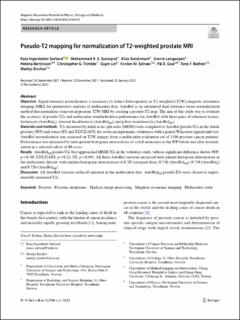| dc.contributor.author | Sørland, Kaia Ingerdatter | |
| dc.contributor.author | Sunoqrot, Mohammed R. S. | |
| dc.contributor.author | Sandsmark, Elise | |
| dc.contributor.author | Langørgen, Sverre | |
| dc.contributor.author | Bertilsson, Helena | |
| dc.contributor.author | Trimble, Christopher George | |
| dc.contributor.author | Lin, Gigin | |
| dc.contributor.author | Selnæs, Kirsten Margrete | |
| dc.contributor.author | Goa, Pål Erik | |
| dc.contributor.author | Bathen, Tone Frost | |
| dc.contributor.author | Elschot, Mattijs | |
| dc.date.accessioned | 2022-02-15T08:27:49Z | |
| dc.date.available | 2022-02-15T08:27:49Z | |
| dc.date.created | 2022-02-14T11:07:08Z | |
| dc.date.issued | 2022 | |
| dc.identifier.issn | 0968-5243 | |
| dc.identifier.uri | https://hdl.handle.net/11250/2978951 | |
| dc.description.abstract | Objective
Signal intensity normalization is necessary to reduce heterogeneity in T2-weighted (T2W) magnetic resonance imaging (MRI) for quantitative analysis of multicenter data. AutoRef is an automated dual-reference tissue normalization method that normalizes transversal prostate T2W MRI by creating a pseudo-T2 map. The aim of this study was to evaluate the accuracy of pseudo-T2s and multicenter standardization performance for AutoRef with three pairs of reference tissues: fat/muscle (AutoRefF), femoral head/muscle (AutoRefFH) and pelvic bone/muscle (AutoRefPB).
Materials and methods
T2s measured by multi-echo spin echo (MESE) were compared to AutoRef pseudo-T2s in the whole prostate (WP) and zones (PZ and TZ/CZ/AFS) for seven asymptomatic volunteers with a paired Wilcoxon signed-rank test. AutoRef normalization was assessed on T2W images from a multicenter evaluation set of 1186 prostate cancer patients. Performance was measured by inter-patient histogram intersections of voxel intensities in the WP before and after normalization in a selected subset of 80 cases.
Results
AutoRefFH pseudo-T2s best approached MESE T2s in the volunteer study, with no significant difference shown (WP: p = 0.30, TZ/CZ/AFS: p = 0.22, PZ: p = 0.69). All three AutoRef versions increased inter-patient histogram intersections in the multicenter dataset, with median histogram intersections of 0.505 (original data), 0.738 (AutoRefFH), 0.739 (AutoRefF) and 0.726 (AutoRefPB).
Discussion
All AutoRef versions reduced variation in the multicenter data. AutoRefFH pseudo-T2s were closest to experimentally measured T2s. | en_US |
| dc.language.iso | mis | en_US |
| dc.publisher | Springer | en_US |
| dc.rights | Navngivelse 4.0 Internasjonal | * |
| dc.rights.uri | http://creativecommons.org/licenses/by/4.0/deed.no | * |
| dc.title | Pseudo-T2 mapping for normalization of T2-weighted prostate MRI | en_US |
| dc.type | Peer reviewed | en_US |
| dc.type | Journal article | en_US |
| dc.description.version | publishedVersion | en_US |
| dc.source.journal | Magnetic Resonance Materials in Physics, Biology and Medicine | en_US |
| dc.identifier.doi | https://doi.org/10.1007/s10334-022-01003-9 | |
| dc.identifier.cristin | 2001225 | |
| cristin.ispublished | true | |
| cristin.fulltext | original | |
| cristin.qualitycode | 1 | |

